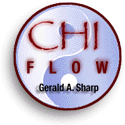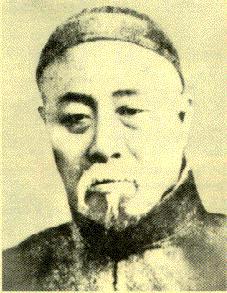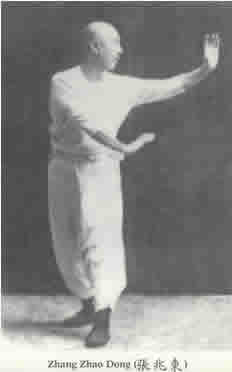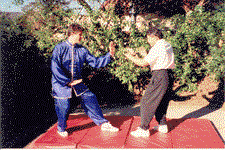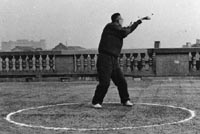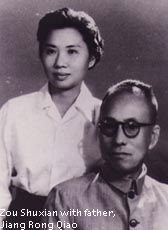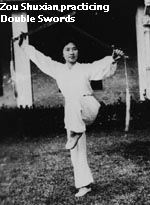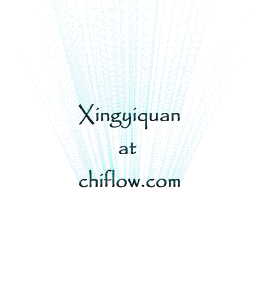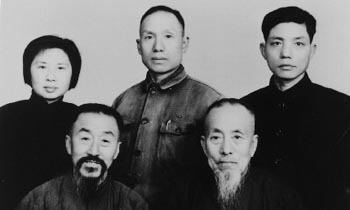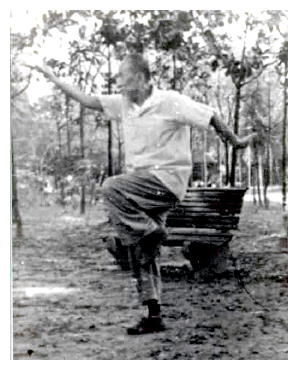
Abridged Biography of Jiang Rong Qiao
Image: Jiang Rong Qiao practicing Neijia kung fu
Although he studied a number of martial arts disciplines and styles, Jiang Rong Qiao left a legacy of a connected and symmetric approach to Nei Jia (Internal or soft style) kung fu: Nei Jia kung fu includes Xingyiquan (Hsing I Ch'uan), Baguazhang (Pa Kua Chang) and Taijiquan (T'ai Chi Ch'uan).
Neijia kungfu
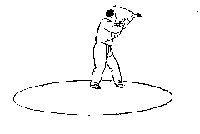 Nei Jia kungfu is the concept of collecting together the entire family of Chinese Internal "soft" styles of kungfu that are also the martial arts associated with Taoism. In some ways, this is analogous to the collection of the entire family of Wai Jia or Chinese External "hard" styles of kungfu into the Shaolin family of martial arts associated with Buddhism. The Neijia movement is sometimes said to be an attempt to return to an older set of martial arts practices. The Neijia movement is also associated with the martial practices on Wu Dang mountain and the Taoist monastery located there. The Neijia kungfu movement has had many proponents going back over generations and running through many styles and regions. In some circles, and particularly in the west, Sun Lutang is perhaps the most prominent figure in the Nei Jia kungfu movement. In other circles, Jiang Rong Qiao is a better known proponent of the Neijia kungfu movement. Jiang Rong Qiao's Neijia kungfu system of Baguazhang (Pa Kua Chang) and Xingyiquan (Hsing I Ch'uan) appears to be the most widely practiced both in China and throughout the world today. Jiang Rong Qiao's Neijia system also includes a version of Chen style Taijiquan (T'ai Chi Ch'uan).
Nei Jia kungfu is the concept of collecting together the entire family of Chinese Internal "soft" styles of kungfu that are also the martial arts associated with Taoism. In some ways, this is analogous to the collection of the entire family of Wai Jia or Chinese External "hard" styles of kungfu into the Shaolin family of martial arts associated with Buddhism. The Neijia movement is sometimes said to be an attempt to return to an older set of martial arts practices. The Neijia movement is also associated with the martial practices on Wu Dang mountain and the Taoist monastery located there. The Neijia kungfu movement has had many proponents going back over generations and running through many styles and regions. In some circles, and particularly in the west, Sun Lutang is perhaps the most prominent figure in the Nei Jia kungfu movement. In other circles, Jiang Rong Qiao is a better known proponent of the Neijia kungfu movement. Jiang Rong Qiao's Neijia kungfu system of Baguazhang (Pa Kua Chang) and Xingyiquan (Hsing I Ch'uan) appears to be the most widely practiced both in China and throughout the world today. Jiang Rong Qiao's Neijia system also includes a version of Chen style Taijiquan (T'ai Chi Ch'uan).
|
1. Early Years Jiang Rong Qiao (also anglicized as Chiang Jung Ch'iao) was born in Qiang County in Hebei Province in 1890. He is widely recognized as an inner door student of Zhang Zao Dong (AKA Zhang Zhankuei). Zhang Zao Dong had studied with both Dong Hai Quan and Liu Qi Lan. Jiang also studied with Li Cun Yi, a Kung Fu brother and one time business partner of Zhang Zao Dong. Jiang Rong Qiao started his training as a student of the Shaolin Kung Fu art of Mi Zhong Quan with his father, Jiang Fatai, and his father's younger brother, Jiang Detai, and later he studied more formally with his uncle, Chen Yushan learning Mizhong Whip, sword, spear, and Qinna. It should be noted that this whip, is flexible cane made by wrapping flexible steel with wood. Together with Chen Yushan, Jiang Rong Qiao traveled throughout China, and enjoyed a variety of experiences. When he first heard of Neijia Kung Fu (Internal Work), Jiang reportedly thought it silly and a waste of time. Later, when Jiang Rong Qiao came to know Internal Kung Fu, he looked back and laughed about how ridiculous he was because he had prejudged the value of Internal Martial Arts. The three main styles that make up Neijia Kung Fu are Baguazhang, Taijiquan, and Xingyiquan. In 1914, Jiang Rong Qiao met Li Cunyi ( a student of Dong Hai Quan and Liu Qi Lan), also known as Single Saber Li. He studied with him for six years, but did not become Li's inner-door student. According to Jiang, Li provided systematic guidance and put his heart into his teaching.
|
2. Zhang Zao Dong and Li Cun Yi
The following year Jiang Rong Qiao met Zhang Zao Dong (or, Zhang Zhankwei), also called "Lightning Hands" Zhankuei. Jiang followed him to Tianjin wanting to become his close student. However, after trying to run down the elusive Zhang, traveling back and forth between Tianjin and Ningbo, Jiang suffered a variety of sicknesses and a high fever. He finally met Zhang in Ningbo and Jiang Rong Qiao was able to begin his studies formally with Zhang Zao Dong which continued for a total of 18 years. While Jiang had been formally accepted as a student of Zhang Zao Dong, he also occasionally consulted Li Cun Yi. Zhang Zao Dong and Li Cun Yi had taught together as early as 1911 when they established The Chinese Martial Arts Teaching Association in Tianjin. While Jiang Rong Qiao did study with Li Cun Yi, Jiang credited much of his formal study to Zhang Zao Dong. Jiang Rong Qiao's adopted-daughter, Zou Shuxian, also verifies that Zhang Zao Dong was Jiang's major influence.
|
|
3. Other Influences Later Jiang traveled to Henan and visited the Chen Family village (Tai Chi\\'s homeland) and Song Mountain (birthplace of Shaolin Kung Fu). Additionally, he went to Hubei and to Wu Dang Mountain. Through his journeys and research, Jiang concluded that Baguazhang and Xingyiquan were not developed on Wudang Mountain as is often purported. Instead, he found that Baguazhang was transmitted by a Daoist to Dong Haichuan, who popularized it in modern times, and that Xingyi was taught to Yue Wumu by a Daoist from Yu Hua Mountain. Yue Wumu taught Ji Longfeng who organized and promoted Xingyi like no one else before him.
|
4. Teaching In 1926, Jiang Rong Qiao was invited to teach at the Nanjing Guoshou Institute at the request of Li Jinglin who also encouraged Jiang to head up the publishing of works, which included some of Jiang\\'s very own titles. Jiang\\'s popularity grew at this time for the many books he began publishing well into the 1930\\'s. Many of these books have been translated into English, by Joseph Crandall of Pinole, California, including:
Other books Jiang is said to have authored are:
|
|
5. Going Blind
In 1955, Jiang suffered an accident that gradually caused permanent damage to his optic nerve. With the help of his adopted daughter, Zou Shuxian, she and Jiang traveled throughout China seeking a variety of cures, which proved fruitless. More and more, Jiang was forced to rely on his adopted daughter, Zou Shuxian, to teach classes. He also employed her to assist him in not only teaching, but in proofreading, while he wrote what could be his most prominent book, "Bagua Palms Practice Method." This is an important book in modern martial arts history, as it was the first Bagua book published in China after the 1949 struggle between the Communists and Nationalists. With drawings by Zhou Yuan Long, who also drew Yang Chengfu, Chen Fake, Chen Zhaokwei, Hao Shaoru, to name a few, Jiang not only produced a model book whose illustrations immediately aligned him with many influential Internal Martial Artists, but brought to the forefront the symmetrical aspects of the Old Eight Palms in writing. To this day many practice his version of Baguazhang and think of it as the original form from Dong Hai Quan. Jiang taught a second Bagua form, which unleashed Fa-jing (Explosive Force) training known as the 72 Leg Techniques. |
6. Symmetry in Practice One of the first books written on the 72 Leg Techniques was written and published in October of 1993, by Zhao Zhong Chong, a grand student of Jiang Rong Qiao, and a professor at the Beijing Sports University. Jiang did develop a combat, combined form with other teachers from the Nanjing Guoshou Institute in the late 1920's, but unfortunately this "combined" form lacks the specificity of the traditional forms Jiang had learned from Zhang Zao Dong and Li Cun Yi. Some of the most interesting forms Jiang taught were the Bagua Sword, in which this extremely long sword form is symmetrical not only in movement and shape but the sword switches hands perfectly, and whatever is done with the right hand is also performed with the left. This same form serves as a template for his famed, "Bagua Suan Jian," or Bagua Double Sword. Both of these forms teach the student a barrage of strategies, and the switching of the hands with the single straight sword along angular and circular attacks gives fencers, who often train in linear modalities, a run for their money.
|
|
7. More about Jiang Rong Qiao's Nei Jia kung fu His most definitive Xingyi weapon was the Gou Dao, which is a unique set of broadswords with hooks, that are fashioned more like long Deer Antlers and axes than hooks or twin broadswords. Other interesting and unique forms passed down or developed by Jiang include his Neijia Kung Fu forms. Jiang was instrumental in developing sets that combined Bagua, Xingyi, and Taijiquan much in the same way another famous Neijia adept, Sun Lutang, combined his Bagua and Xingyi with Wu Yuxian (also called Hao) style Taiji. Jiang, too, developed a Tajiquan set known as Taiji Zhang Quan (or Tai Chi Palm and Fist), which is based on sequences from Jiang\\'s Bagua and Xingyi, as well as the Old Chen Style T\\'ai Chi he had studied. Another Nei Jia set is his Nei Jia Bian (or, Internal Shaped Whip). This whip is a flexible steel rod wrapped with wood, and it\\'s hard to say how much of this form was influenced by his early studies of Mi Zhong Quan, but regardless the Nei Jia Whip remains one of the most unique weapons practiced in the Chinese Martial Arts. His Internal Shaped Whip is comprised of two series with the second set containing more intricacy and fa-jing than the first. In true Jiang fashion, remnants of the Bagua Sword and Broadsword, Xingyi Sword and Broadsword, as well as his exposure to and take on Taiji are all found in the two series of his intricate whip, or cane-like, martial arts sets.
|
8. A Legacy of Students with Skill
Jiang continued to lecture throughout the country, despite the progression of his blindness. He and Zou Shuxian would often demonstrate two-person Bagua together publicly. He died in 1974 at the age of 84. He is buried near Suzhou and is remembered as one of the most famous exponents of Internal Martial Arts in modern times. His top students were Sha Guozhen, Zou Shuxian, Ji Yuansong, and Yang Bangtai. Other students who were close to Jiang include Huan De Hai, Pei Xirong, Zhang Wenguang, Cao Gong, Lu Yongcai, Wan Tiansheng, Jiang Zhongyi, Jiang Zhongtao, and others throughout Shanghai, Beijing, Tianjin, Nanjing and now throughout China and around the world. |

